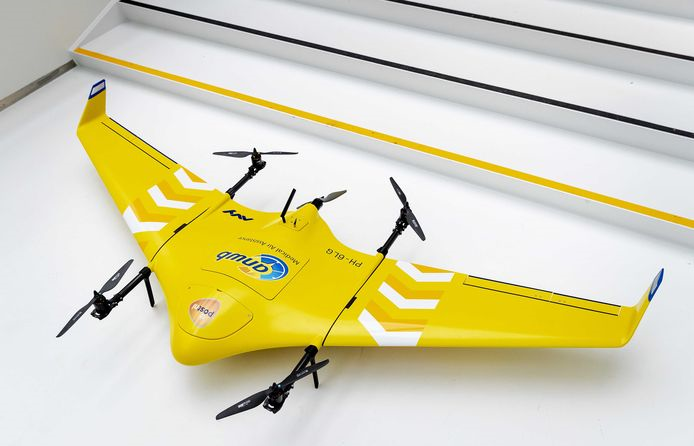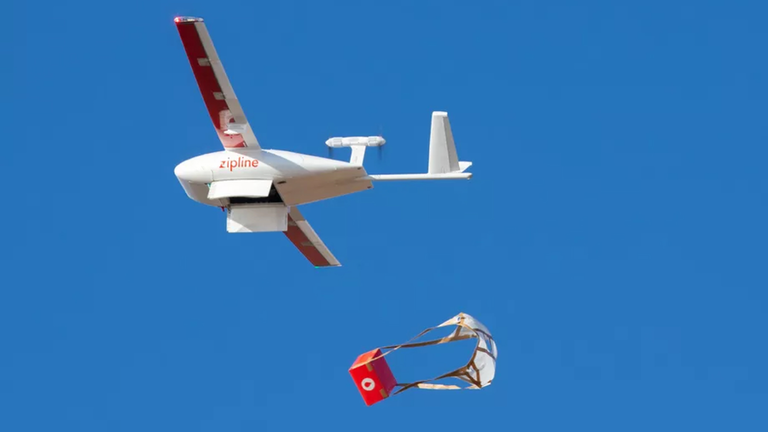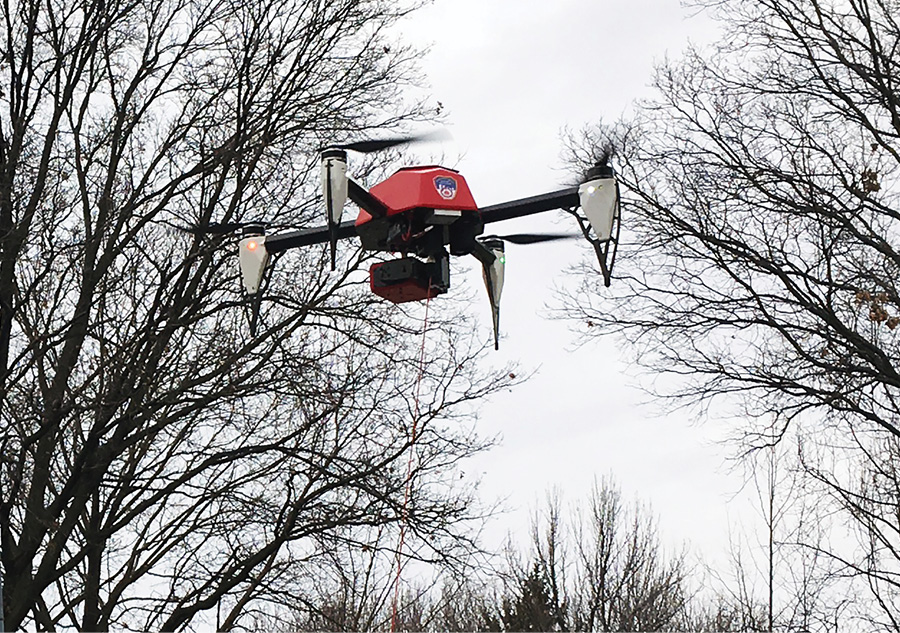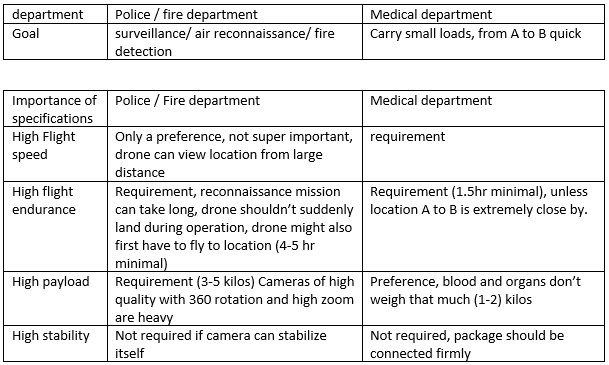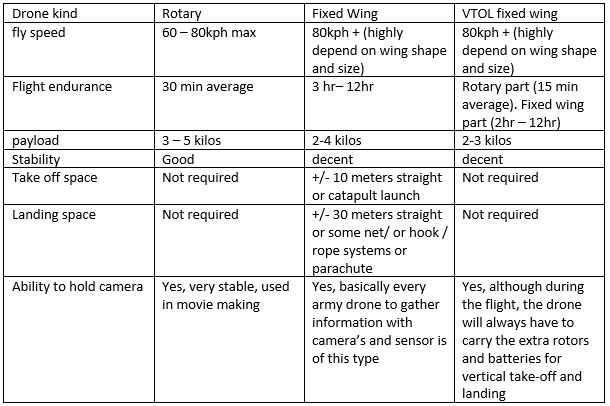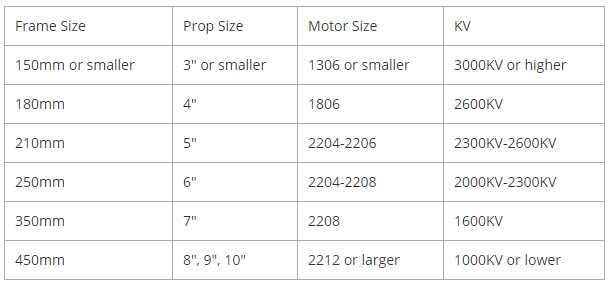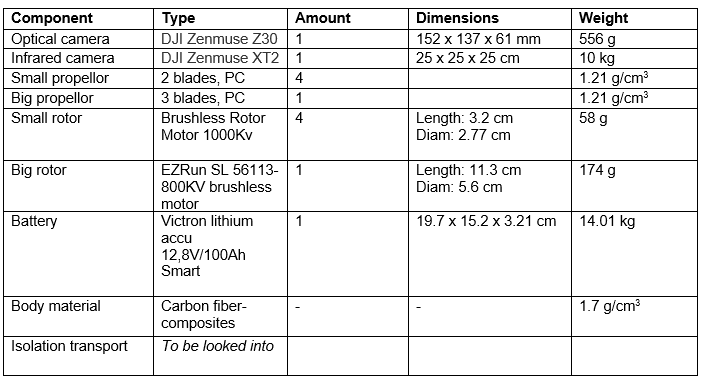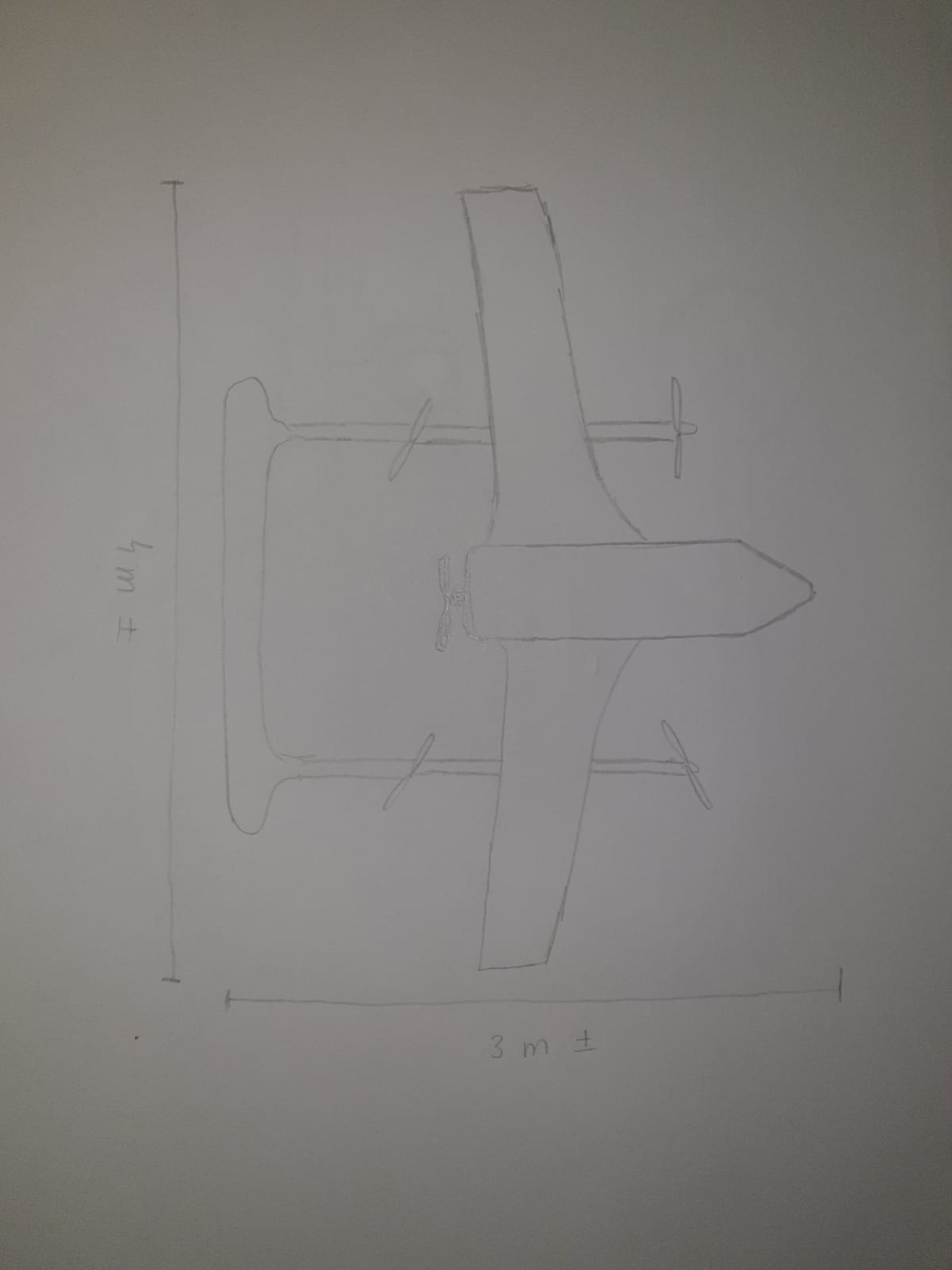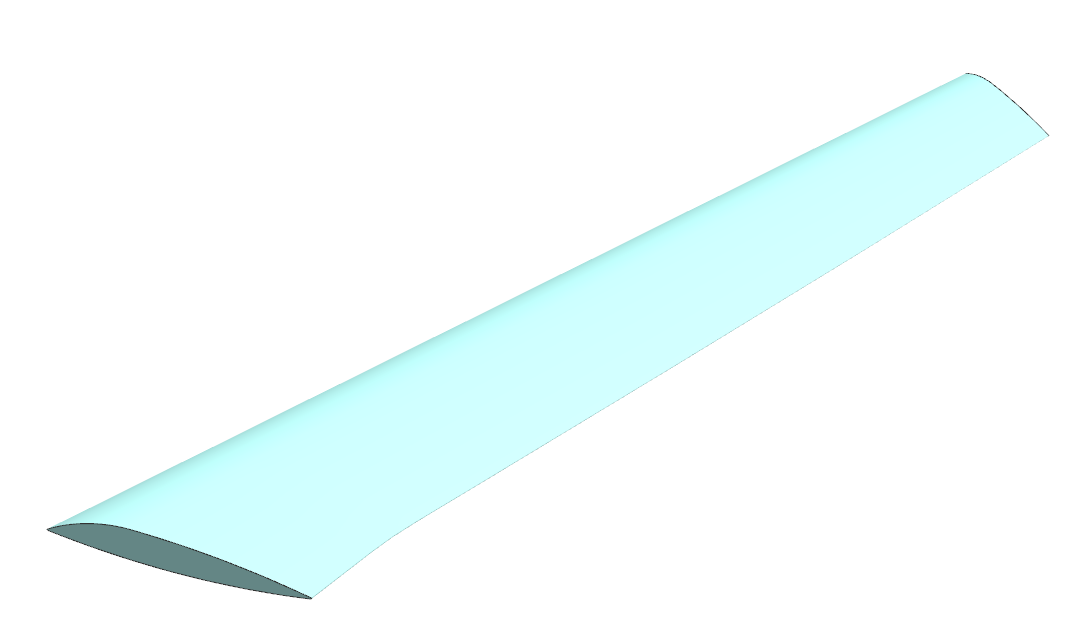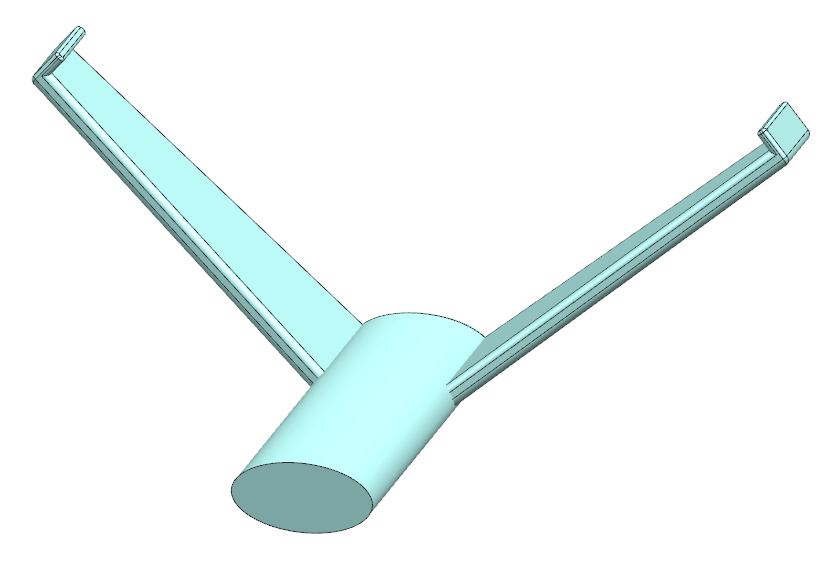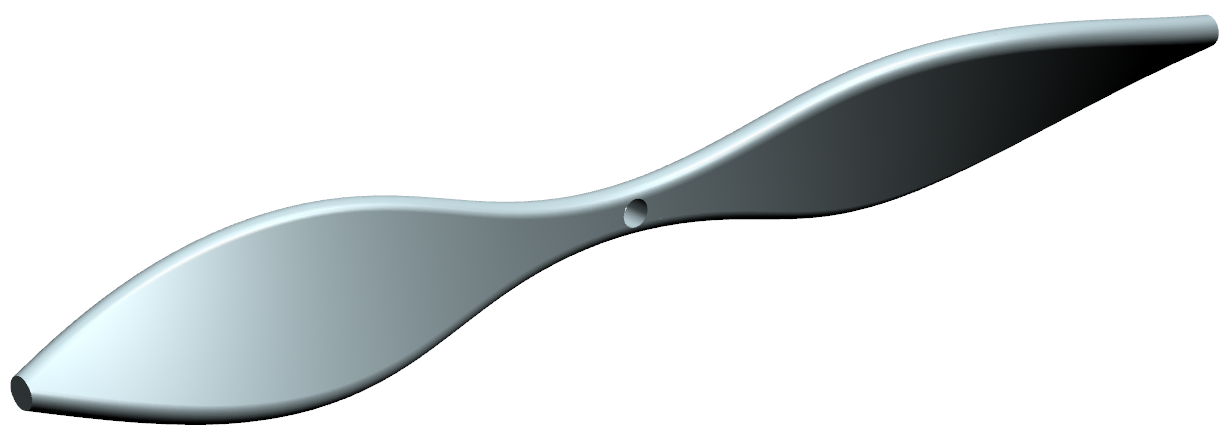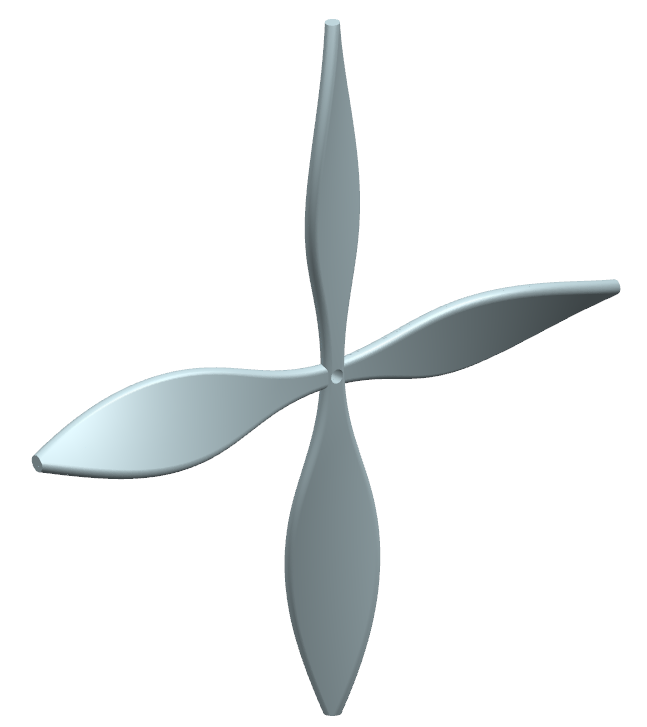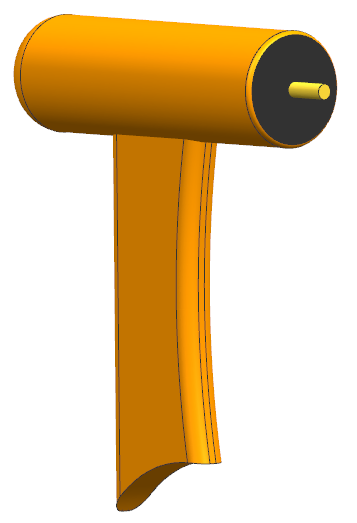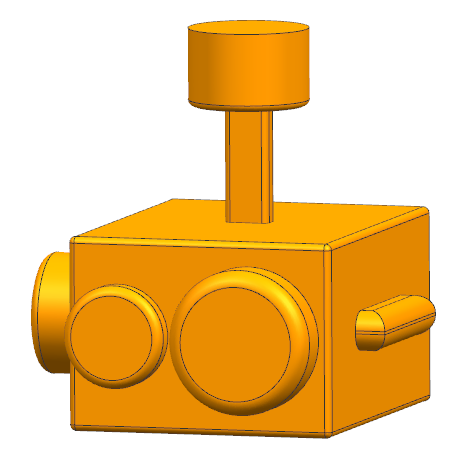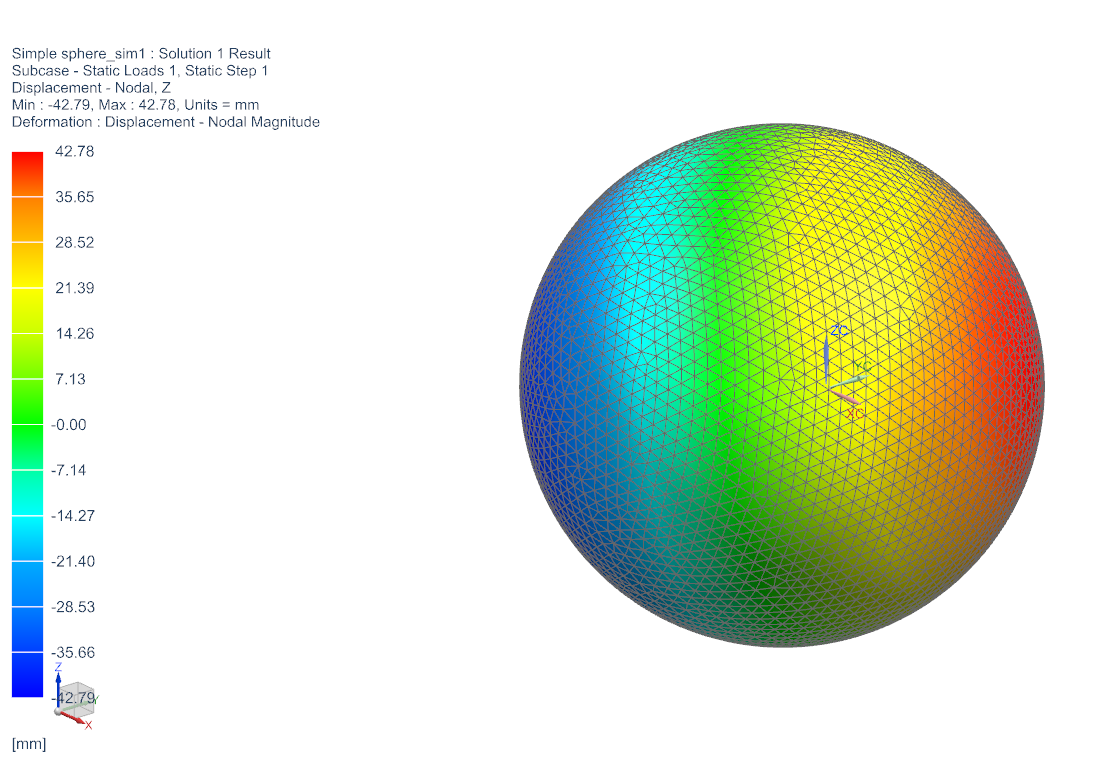PRE2020 3 Group5
Emergency Drone
Group Members
| Name | Student ID | Department | Email address |
|---|---|---|---|
| Pepijn Hundepool | 1427520 | Mechanical Engineering | p.c.j.hundepool@student.tue.nl |
| Lucas Commissaris | 1451065 | Mechanical Engineering | l.f.h.commissaris@student.tue.nl |
| Sven Passier | 1448781 | Mechanical Engineering | s.w.l.passier@student.tue.nl |
| Bram van den Buijs | 1464647 | Applied Physics | b.v.d.buijs@student.tue.nl |
| Stijn Borgers | 1495968 | Applied Physics | s.borgers@student.tue.nl |
Problem statement and objectives
The popularity and usage of compact unmanned aerial vehicles (UAVs), better known as drones, has been increasing radically over the past few years [1]. For only a rather small amount of money, you can already get yourself a drone with some basic abilities. In general, three types of drone users are distinguished. The majority of the drone market is represented by military purposes. The remaining market share is represented by consumer (e.g. hobbyists) and commercial usage. The commercial usage groups will be the point of focus for this project. These drones can have a broad range of different purposes, such as 3D mapping, delivery, inspections, data transmissions, and video collection. Although this group represents the least percentage of sales of the three aforementioned sectors, the revenue value in 2016 was about 60 percent more than the one following from consumer purchases. This phenomenom is mainly caused by the fact that price tags of about $100,000 are no exception in such industries.
A sector that does not really match the term 'comercially' as it regards the type of institution, but does regarding the production price tag, are drones used by governmental bodies. In specific it concerns departments that are of key-importance in emergeny situations, with the three most central ones being respectively the police, firefighting and medical (ambulance) departments. In these departments, try-outs and permanent involvements of drones become more and more part of the job [2]. However, since these drones often include high-advanced technologies, their production costs can rise to serious heights. A proper police drone for example lies in the purchasing range from $50,000 to $200,000 [3].
This project aims to develop a new type of drone, which will be able to carry out tasks for more than one of these departments. Roughly sketched, this will result in a drone with a range of standard functions, on which a specific variation of equipment can be (de)attached. This multifunctional drone will have multiple benefits over the development of drones that are specified per department. The most important one, as already indicated in the foregoing, will be the cost-effectiveness. This would for example be benefitial for regions that might lack budget to invest in innovative technologies such as drones, but still strive to develop the implementation of high-tech equipment in their daily work. A second benefit, partially cohesive with the previous one, is that drones can be used more efficiently at for instance an incident or natural disaster, where often more than one department is providing assistance. Since the equipment can be varied for multiple departments, different tasks can be executed with the same drone. As a result, when at a certain moment in time a department is not using their drone(s), other departments can make use of it instead.
Deliverables
This project aims to have the following deliverables at the end of the quartile:
- A study on the experiences and thoughts of the primary users on the development of drones in their expertise.
- A conceptual CAD model of an emergency drone, which should be able to be used by all three main departments. This model will focus rather on the design and type of functions it should be able to perform, to a great extent based on the primary user study, than to show a detailed view on the exact controls that would be required.
- A FEM-analysis on the CAD-model, to show the impact of external forces on the drone's design
- A simulation of the CAD model in Simcenter to show how the drone will propel
- A wiki page shows the consecutive steps that have been taken to accomplish the deliverables stated above
User, Society and Enterprise
In this section the different stakeholders of our project will be investigated and elaborated on.
Users
The primary users of the emergency drones are the civil servants that work in the fire, police and medical department. To be more specific: within the fire department the drone will be used as a fire-reconnaissance tool, within the police department it will be used for surveillance and finally within the medical department the drone will be used for the transport of goods between hospitals.
The secondary users are all civilians. Civilians could be trapped inside a burning building, they could be under surveillance or they could be in a hospital with the need for a certain essential good like blood. In all these cases, civilians are on the receiving end of a emergency drone.
Sampling the users
We wanted to confirm and further investigate the user needs, so we set up a questionnaire for each of the three departments. We asked a few questions about technical specifications and how drones could be used best. We also asked them about their attitude towards the implementation of drones into their work to confirm that the users would want to use drones, this is not necessary for the result of our project but it does help confirming the usefulness of it.
After realizing that an interview would be more beneficial for our research, we conducted one. Elaboration can be found in the section below. We did not get any response from the police department. Neither with the questionnaire nor the interview (of which the emails were send to different addresses).
Questionnaire
The answers we got were the answers we expected but we were still missing something. We realized that the questionnaire would either need to be reformulated so that the answers would be useful to us or we had to find another way to get information. In the end we decided to conduct an interview. The reasoning was that if we were to get in contact with even one person that is working with drones, we would be able to obtain more knowledge then with an answer of a multiple choice question. Even an answer to an open question would be subpar.
The results of the questionnaire can still be found in Appendix C.
Interviews
To have a more in-depth understanding of certain technical difficulties and choices, we interviewed some people from each of the three different sectors. These people specialized in the development of the drones to support their respective sectors. We have interviewed 5 people in total and summarized their answers to the different interview question. We will first introduce the participants. Below that will be questions and summarized answers (results).
People
Here the people that we have interviewed will be introduced.
Fire department:
1. Mark Bokdam (Linkedin): Chief officer of the fire department in Twente and a board member at the SWOD foundation on behalf of the Dutch Fire Department. He has worked for the fire department for over 11 years and is the contact for any questions about the drones teams of the fire department.
2. Robbert Nijs (Linkedin): Policy advisor IRA (information, research and analysis) for Mid- and West-Brabant. 19 years of experience with working for the fire department
Medical department:
1. Jaap Hatenboer (Linkedin): Vice president and the Policy and Innovation manager at UMCG Ambulancezorg. In his daily life he deals with new developments surrounding transportation in the health sector. But also the organization of the healthcare department he works in.
2. Mirjam Meerkerk: Paramedic and part of Axira. Axira is a partnership between independent regional organizations that now operates nationally for ambulance care. They say that they combine their knowledge and experience to make innovations faster, better and cheaper
[4].
In Anne-Jan's daily life he encounters accidents, cerebral infarction, people in panic and he uses psychiatry to calm victims and/or their relatives.
Questions and answers
Here you can find the questions and the answers from the interviews. The answers will be combined and summarized for the convenience of the reader.
Fire department:
- How do you see drones be used by the fire department?
The drones that are used in The Netherlands today are for areal reconnaissance. These drones are equipped with an optical camera (DJI Zenmuse Z30) and an infrared camera that also has an optical camera inside of it (DJI Zenmuse XT2), so it can produce a video with both optical and infrared footage overlapped.
- Drones are not used to extinguish fires in The Netherlands. Why?
Water is quite heavy, so to compensate the forces to carry and fire this water, the drones will have to have quite a lot of power. This means these drones will be very heavy, think anywhere from 30 to 400 kg. China is already testing with these drones. Robert Nijs doubts that these things can extinguish fires that are inside the building. These drones might be able to carry a good amount of water up but a fire truck will most of the time be more useful. The one exception is if there is a fire in a high story building (which are quite common in China) where a fire truck will probably have difficulties reaching that high, but a drone can just fly up there. According to Mark Bokdam, The Netherlands will start experimenting with firefighting drones within 5 years.
- Do you think it is possible? Maybe even autonomously?
According to Mark Bokdam, The Netherlands will start experimenting with firefighting drones within 5 years. To have a drone be fully autonomous is a whole other question because a drone needs to be supervised otherwise we encounter a responsibility problem. Who will be held responsible for the things that the drone does? The supervisor? The software engineer? The person that mobilized the drone?
- In which range of fires do you see a drone being deployed? Is it useful to deploy a drone for all types of fire?
In most situations a birds eye view is a good information gatherer for a situation with a lot of unknowns.
- Would transporting equipment be useful? Which equipment?
Probably not, because most of the equipment of the fire department is quite heavy and most of the time the ground vehicles can arrive at the location within 5-10 minutes. In most situations this time is short enough to save the situation and the people inside them. Having a single fire extinguisher or a fire blanket arrive 3 minutes earlier does not have a major impact. Maybe in the future.
- How much should a drone be able to carry?
The current drones can carry around 4.5 kg. This is enough to carry the sensors for the surveillance, but not nearly enough to carry a useful amount of water for extinguishing fires.
- What type of drone would be the most useful? a quadcopter, a fixed wing drone, and a hybridcopter (which is a combination of both)?
Fixed wing/hybridcopter is useful for surveying large fires, such as forest fires. This type of drones has not yet been implemented, but it would be a good addition to the tools available. The drones that are currently in use at the fire department are quadcopters, these drones provide a birds eye view with both an infrared camera and an optical camera.
- How can your drones be improved?
Longer batteries, better sensor package, stronger rotors, basically just standard technological improvement. The other thing is the previously mentioned fixed wing drones which can survey large areas and can stay in the air longer.
Medical department:
- How do you see drones be used by the medical personnel?
Mostly as an information gatherer, so the same as the eye in the sky concept the fire department stated. These types of drones will give a visual overview of the situation for the medical personnel so they wont get surprised by unexpected circumstances when they arrive.
- Would it be useful to transport an AED, organs, antidotes or a first-aid-kit using drones for an emergency call? - Would using drones to transport equipment between hospitals be useful? equipment examples: blood, vaccins, organs, antidotes or first-aid-kits
Helicopters are quite expensive to use. The cost of the vehicle, fuel and the education of a pilot is high. This creates a situation where only in very high demanding situations a helicopter is mobilized and not in all of the situations where the medical helicopter is required can it be mobilized. Transportation using drones is a nice mid-way solution between mobilizing a helicopter and a land vehicle. These drones can be instantly mobilized with small packages of whatever is necessary to whatever location.
- How much should a drone be able to carry?
Around 5kg. This should be enough to carry a sensor package, with an optical camera, an IR camera and maybe a large light. This light will make it easier for the medical personnel to work at night time.
- What type of drone would be the most useful? a quadcopter, a fixed wing drone, and a hybridcopter (which is a combination of both)?
Quadcopter: surveillance / eye in the sky. But sometimes not even this. Jaap Hatenboer argues that it will be more useful to have a fixed wing drone fly loops around the scene. This would make the drone more efficient in energy use and it will create a situation where the drone will have a view of the situation from a wide variety of angles. Fixed wing drone: long distance flights between developed locations, such as hospitals or bloodbanks Hybridcopter: long distance deliveries to for example an emergency caller. It will be difficult for a drone to be useful when the situation is indoors. But the drone might be able to transport aids for the person in distress.
So, most drones can be of use in the medical department, it just depends on the situation. The quadcopter might be the most useless one, especially when technology is able to create a virtual recreation of the situation by having imagery from different angles. This will make a fixed wing drone flying a pattern above the situation more useful.
- How can your drones be improved?
Standard technological improvements like stated in the fire department section.
Society
There are different stakeholders to be considered for the influence of the society. The government is a major stakeholder, because of the legislation of drones for emergencies usage. Animal rights and environmental organizations have a large interest in maintaining and/or improving the current situation. The drone technology could be dangerous and do damage to society. The flying stakeholder who are using the airspace now must be taken into account, like bird, planes or other drones.
The effect on society would be beneficial on a great scale. (source with death due to cardiac arrest). When drones could deliver an AED within 6 minutes, the survival changes would increase significantly. Other medical usage could be the transport of blood or organs. Not only transport of equipment, but also for investigation for the fire and police departments. All of this would increase the safety and save precious time.
Enterprise
In order to realize emergency drones, the product needs to be produced by a technology company. This company will only build, deliver, and repair these drones. The company will work closely together with a government agency. This agency will be responsible for the usage and quality of the drones, after they have been bought from the drone company. A close cooperation between both stakeholders will lead to an better end product.
Whenever an accident happens due to a drone or due to the usage of an drone, this government agency can be hold responsible. The agency will have to test each drone thoroughly, to limit the risks of accidents. The government agency will also be ultimately responsible for the usage of data gathered by drones. The government agency will have to check at police, medical and fire departments how they deal with the information and data form the drones and if all drone deployment regulations are complied. The relation between the agency and the departments could be seen as principal-agent relationship.
When civilians have an unpleasant experience with the usage of drones by a police, medical or fire department or when they simply feel disturbed by the usage of drones in general, the government agency should be contacted. The agency should write a simply report about each of these complains. The agency should also have the tools to track down the specific drone and flightpath, to see if any regulations on drone deployment where infringed.
State of the Art
Transport drones
Medical drone service
Drone company AVY and several partners are currently testing a long range drone delivery service [5]. The consortium, called Medical Drone Service, will research how the system can impact healthcare in the Netherlands. This consortium consists of several companies, that each have their own expertise; the most important ones are: The ANWB (who are also behind the medical helicopters), PostNL (postal logistics), Erasmus MC (hospital) and Sanquin (blood bank).
During this pilot, a distance of 15 km is travelled in a sparsely populated area, and in the current stadium no medical equipment is yet transported. The main transport is meant to consist out of e.g. medicines, blood and urgent medical deliveries [6].
The drone flies autonomously, but is constantly monitored and at any time the control can be taken over. This specific drone is the AVY Aera, which is also called a Vertical Take Off and Landing wing drone. This term, as you might expect, means that it can take off and land vertically, and subsequently fly horizontally. This can be of great advantage in crowded areas, as the vertical landing makes large landing strips redundant. The drone has a wingspan of 2.5 meters and flies with a speed between the 70 and 80 km/hour, which it can maintain for about an hour. The height it flies at is about 100 meters and at the moment it can only transport a maximum load of 1.5 kilograms. An example of a technical challenge that this drone faces is to maintain a certain temperature, as blood has for instance ideal temperatures at which it should be transported [7]. In addition, it doesn’t fly at bad weather conditions.
Zipline drone network
Blood transport
The American drone company Zipline created the world’s first ever drone delivery network for blood transportation in Rwanda (Africa), in October 2016 [8]. Zipline has distribution centers from where the drones are launched. These centers also perform the function of storage and warehousing of blood and the drones. When a doctor places an order for blood to the distribution center (e.g. through a message or call), workers at Zipline takes the blood from the refrigerator, wraps it with insulated paper and packs it in an insulated cardboard box, after which it is loaded in the drone. Subsequently, the drone takes off to deliver the cargo to one of the clinics.
Zipline uses planes instead of quad copters (which uses four rotors), as quad copters uses far more energy to fly. They can’t manage the range from batteries necessary to travel longer distances and are relatively slow as well. On an average, one delivery is completed in 15-45 minutes and it takes 5-7 minutes to launch the drone after receiving the order. Zipline handles approximately 500 deliveries per day. These drones travel with a speed of 100 km/hour, with a range of over 160 km (allowing the drone an 80 km zone around the location). When the drone reaches the delivery location, it descends to 30 feet to deliver the packet.
About the physical components of the drone. It has a wingspan of 3 meters and the maximum load it can handle per flight is 1.8 kilograms. The batteries (lithium ion batteries with a total capacity of 1.2 kilowatt hours) are the heaviest part of the aircraft, making up half of the total weight of the aircraft, weighing a total of 10 kilograms. The aircraft itself thus weighs about 20 kg.
The drone has a few specifics that are worth mentioning. Instead of a regular GPS circuit, a detachable battery is used in which a GPS is present. This was done as the regular one experienced delay when connecting to the satellite. Another point is the fact that the cargo is dropped with a little parachute. As a result, the clinic at which it is delivered does not require any additional infrastructure to land the drone, and the drone can immediately return to the distribution center. The landing system for the drone is impressive and complicated at the same time. At the distribution center, two actuated arms are located, between which a wire is strung. The drone flies towards the arms, which catch a hook attached to the drone, and brake and end the drone’s flight.
Vaccine transport
The company Zipline, which is also behind the delivery drone network for blood discussed above, are starting this spring with delivering COVID-19 vaccines [9]. This will be done in the regions in which they are already active, for example Rwanda, Ghana and Tanzania, but also rural parts of the U.S.
A big challenge presented by many of the vaccines, is their temperature requirement. The Pfizer vaccine for instance has to be stored at minus 70 degrees Celsius. To overcome this issue, Zipline will store vaccines in ultra-cold freezers at its distribution centers, and when a clinic needs vaccines, the drones can make a delivery within roughly half an hour. As a result it allows rural and remote health facilities to bypass the need for having the freezers themselves.
Surveillance/reconnaissance drones
Eye in the sky
On their website the West Midlands Police in the UK discuss the way drones can be used to assist officers in scanning large areas in a short amount of time. [1]These areas being: crime scenes, hard to reach areas, major incidents or looking for missing persons. The drones cost between 2.000 and 10.000 pounds (2.320-11.600 euros). The drones are operated by specially qualified officers that have trained under the Civil Aviation Authority (CAA) regulations. The drones are used for a short 15 minute period of time to minimize noise concerns. The drones are allowed to fly up to 120 meters high. The smallest drone has a top speed of 65 km/h. The drones can fly within 500 meters of the pilot. They make use of a lithium-polymer battery that can be charged either in buildings or on police vehicles.
The Fire Department of New York (FDNY) has been using tethered drones at incident scenes since March 2017. [10] The HoverFly drones are equipped with video and infrared cameras. They are able to evaluate fire travel, structural issues like cracks in a building or danger of collapse, and roof operations to determine if anything is unsafe and needs corrective action. HoverFly drones have a constant power source and are able to give very clear pictures. The drones are operated by pilots that are part of a command tactical unit that is dispatched from the FDNY command center.
The Millstone Valley (NJ) Fire Department in Franklin Township Fire District No. 1 uses DJI drones [10]. First they had an off-road search and rescue team that used Polaris Ranger utility terrain vehicles and a 4×4 brush truck but then they realized how practical a drone would be. In the first year of usage, they found multiple lost hikers using drones. Millstone Valley also has used its drones on special call from the New Jersey Forest Fire Service, for prescribed burns and uncontrolled wildfires. With the drones, they are able to determine where the fire is and to predict where it goes.
To be added sources:
[1] https://www.west-midlands.police.uk/frequently-asked-questions/police-drones
Design research
Drone requirements
Before I could make a start on the actual design of the drone, I first need to know what the purpose of the drone is (for what department will the drone work?). This is still not completely clear, however we were sure that the drone for the police department and the fire department will need to carry a large camera for surveillance/ air reconnaissance/ fire detection. The tasks of the two departments can be carried out by a somewhat similar drone. For the medical department the drone only needs to carry a relative small load. I now looked at what type of drone best fits these tasks. I first made a table with the requirements for the drones of each department, since the fire department and police department require somewhat the same, I placed them together.
The correct drone type
I now had an idea on some requirements for each of the drones. I started looking at the state of the art of drones and what drones would fit the best for our cases. I looked at rotary drones (fig 2), fixed wing drones (fig 3) and VTOL (Vertical Take-Off and Landing) fixed wing drones (fig 4).
Recommendation: I would recommend to use a Fixed wing/VTOL fixed wing drone for police/fire department, it can hold a camera and has high flight durability And for the medical department I would advise a Fixed wing, the drone will usually always fly between certain locations, so a landing system and launch system/ location can be build on these locations. This drone will be the fasted since it does not have to carry additional weight of extra rotors and batteries like the VTOL fixed wing.
Propellor
Regarding a desired flight velocity and energy consumption, the design of a drone’s propellor is of great importance. For a multirotor propellor there are a few key variables that need to be considered in the its design: The size, the pitch, the blade configuration and the material [11]. These variables discussed here will mainly hold for rotary drones, but the general aerodynamics and energy consumption can be also be used for other drone types (e.g. fixed wing).
First of all, the size. The main difference between a small and large propellor is the power consumption and level of thrust. Larger propellors sweep more air and thus take more energy to get spinning. These will have more thrust and can fly more steadily. Smaller ones require less power and will be able to change altitude more rapidly. Just as important as these considerations, is the requirement of a well matched motor. If a small propellor is placed on a motor made for bigger sized propellors, it will lead to a too high RPM with very little thrust. A typical diameter is around 8 to 9 inches [12].
The pitch of a propellor refers to the angle of each of the blades on the propeller. A high pitch will lead to more overall thrust and top speed, while a low pitch increases the response time and uses less power. A propellor with low pitch is only efficient at low speeds, while a high pitch is more suitable for flying in large open areas.
The amount of blades on a propellor is referred to as the blade configuration. Increasing the amount of blades will not have that much of an effect as increasing the size. Many blades are more suitable when flying in places where making fast turns is a requirement, while less blades are when thrust is less critical. In general, tri-blade propellors provide the best balance between efficiency and thrust [13].
Finally, the material of the propellor, for which polycarbonate is a very common option, known for its good stiffness. Material choice depends also on the climate in which the drone is operating. In a hot climate for instance, glass fiber might be needed to reinforce the propellor, as other materials (e.g. polycarbonate) can become soft and thus less efficient.
Rotor
A rotor is the common name for the combination of a motor with a propellor. In general, multiple rotors are either symmetrically or co-linearly attached to a drone’s frame. There are a few key specifications for these motors. The operating voltage is typically 11.1 or 14.8 Volts, in combination with a three or four cell Li-Po battery. Another important variable is the amount of kilovolt of the motor, which is also indicated as the rotation speed per Volt. From this relation it becomes immediately clear that the propellor will spin faster at a higher kV (RPM/V) rating. However, it is important to keep the balance between the amount of kV and the size of the propellor. For instance, a too high kV combined with a too large propellor will require more torque and can subsequently generate too much heat or even overheating [14]. The weight of one single rotor is usually between the 12 and 20 grams.
The table below provides an indication of several components of a drone (a quadcopter specifically here) relate to each other [15].
| Frame size | Prop size | Motor size | Energy |
|---|---|---|---|
| 150mm or smaller | 3" or smaller | 1306 or smaller | 3000KV or higher |
| 180mm | 4" | 1806 | 2600KV |
| 210mm | 5" | 2204-2206 | between 2300KV and 2600KV |
| 250mm | 6" | 2204-2208 | between 2000KV and 2300KV |
| 350mm | 7" | 2208 | 1600KV |
| 340mm | 8", 9", 10" | 2212 or larger | 1000KV or lower |
For drones, two main types of motors are distinguished: Brushed and brushless [16]. This distinction is based on the way of generating a magnetic field, which is done through permanent polarity for a brushed one and switching polarity (with a permanent magnet) for the brushless one. The brushed version is commonly used for very basic (consumer) drones, while the brushless one is often used in larger drones, as it has a wider speed range and longer lifespan.
With this knowledge and the info from the table can be concluded that a brushless motor should be used, in combination with a KV value that is not too high. Since the frame from the drone that is to be designed for this project will be near the 450 mm or even a bit more, the lower row of the table will be taken as reference, with the KV of 1000 or lower.
Power Source
Combustion engines
A drone will need a power source to power the propellers and generate lift. There are different ways of powering a drone. Most drones use batteries to power their electric components. The most batterie for powering a drone is a Lithium-ion (Li-ion) battery. Not every battery is meets the requirements for powering a drone. The battery needs to have a high discharge rate, high energy/weight ratio and a fuel gauge is essential for showing the user when a landing is required.
When drones get bigger, they generally have the ability to lift more weight. Especially in fixed wing and VTOL fixed wing drones, the market shows that when drones get larger in size the way of powering a drone changes. Since becomes bigger, the possibility of using an combustion powered engine opens up. These engines are able of powering the drone for long periods of, dependent on the size of the fuel tank. In 2017, MIT engineers build an gas powered fixed wing drone, that was able of staying in the air for 5 days. The engines used in these drones are usually one or two cylinder engines, weighing between 1.3 to 7.3kg and they have power outputs ranging from 1.6kW to 18.9kW
[17].
A fixed wing drone will need one combustion engine to operate, however a VTOL fixed wing drone will also need additional batteries to supply power to the propellers performing the vertical take-off and landing. An endurance focused VTOL fixed wing drone can be called a ‘hybrid’, since it combines multiple energy sources. An example of such endurance focused drone is the ALTI Transition
[18],
this drone combines an electric and fuel power and is ably to fly up to 12 hours.
However, the drone that is to be designed in this project, does not have the requirement to fly for such a long time. As stated already above, there is a wide range of fuel motors that are used in UAVs [19]. When looking into one of the smallest versions, a 32 cc [20], it becomes clear that these already can bring along some practical problems. For this one, the basic engine weight is already 1.3 kg, while in total with all components/accesoires it sums up to about 2.7 kg. In addition, it of course will need fuel to run, 93 octane to be precise. Such a fuel has a density in the range from 0.715-0.790 kg/L [21]. On a long flight, e.g. 120 km, a minimum of about 5 kg of fuel will be required. Combining this with the engine’s weight, a total of 8 kg will be represented by this part of the drone alone.
This is especially high when comparing it to the weight of components for the current relevant drones, discussed in the section State of the Art. The weight of a Zipline drone’s battery for instance is about 10 kg, while a drone with a fuel motor (especially of this size) will need electric support as well, subsequently exceeding this value with a significant amount. Furthermore, on a societal note, with the rapid developing energy-transition in mind, the usage of fuel is also not likely to stay relevant and ‘acceptable’ for many years.
Battery packs
The battery pack used by the Zipline drone comes down to a total capacity of 1.2 kWh. Such a range should also be strived for the drone to be developed here, as a similar size and transport load will be used. Then there are two options: Either to use multiple, separate batteries (e.g. for each rotor one), or to implement one larger one, that is connected to all rotors via a circuit. The latter one seems to be the most space-efficient option, as these packs can be quite robust. Since the middle part of the drone will already contain some sort of bulge, the drone’s frame only has to be adjusted to the battery pack here, instead of at multiple spots (e.g. towards the sides/wings).
For non-consumer drones (the scope outside the hobbyists), the specific battery packs used are often not revealed or at least can not be found easily. Therefore, a reference battery pack will be used, the ‘Victron lithium accu’ [22], which also has a capacity of about 1.2 kWh. This one is not specifically created for the usage of drones. It weighs 4 kg more than the one Zipline uses, which makes a significant difference of 40 percent in weight. From this one can assume that the volume of the two packs will also differ with a similar percentage. Therefore, in the CAD model, the battery pack will be modelled with the dimensions of the Victron lithium scaled with a factor of 0.71, to make it more realistic.
Cameras
In our interview with Robbert Nijs (see interviews) he mentioned the types of cameras that are currently used within his field. The drones that are used in the Netherlands are equipped with an optical camera (DJI Zenmuse Z30) and an infrared camera that also has an optical camera inside of it (DJI Zenmuse XT2), so it can produce a video with both optical and infrared footage that are overlapped.
Material
An important preference of any aerial vehicle is to be as lightweight as possible [23]. With this main preference in mind, there are several other material aspects that are important for a certain vehicle. Airplanes for example use aluminum because of it being lightweight, yet strong, allowing the plane to carry more weight or become more fuel efficient. Another material that excels at being strong, yet lightweight, is carbon fiber composite. It has a density of 1.7 g/cm3. Because of this low density, the drone will be able to stay in the air longer due to decreased fuel usage over time. Furthermore, carbon fiber composites are age resistant and thus require no needless upkeep.
Design
Reference components
In order to make the CAD model and corresponding simulations realistic, a list of reference components will be used. These components give an indication of the properties of the most relevant equipment and parts. It should be noted that these components are thus mainly used to visualize the concept of the emergency drone, rather than to be stated in a detailed interconnected network, such as a system's blueprint would be.
| Component | Type | Amount | Dimensions | Weight | Source |
|---|---|---|---|---|---|
| Optical camera | DJI Zenmuse Z30 | 1 | 152 x 137 x 61 mm | 556 g | Link |
| Infrared camera | DJI Zenmuse XT2 | 1 | 25 x 25 x 25 cm | 10 kg | Link |
| Small propellor | 2 blades, PC | 4 | 1.12 g/cm3 | ||
| Big propellor | 3 blades, PC | 1 | 1.12 g/cm3 | ||
| Small rotor | Brushless Rotor Motor 1000KV | 4 | Length: 3.2 cm Diam: 2.77 cm |
58 g | |
| Big rotor | EZRun SL 56113-800KV brushless motor | 1 | Length: 11.3 cm Diam: 5.6 cm |
174 g | |
| Battery | Victron lithium battery 12.8V/100Ah | 1 | 19.7 x 15.2 x 3.21 cm | 14.01 kg | |
| Body material | Carbon fiber-composites | 1 | 1.7 g/cm3 | ||
| Isolation transport | To be looked into |
Sketches
For the sketches we looked at similiar VTOL fixed wing drones. We also thought about all requirements for the design.
Dimensions
For the dimensions we looked at other VTOL fixed wing drones. It is important that the drone is big enough to carry a couple of kilos. Also the drone must be able to stay upin the air for multiple hours. It was decided for now that we are going to give the drone a wingspan of +/- 4 meters.
CAD
Wing
We already made a start on the CAD design this week. However the progress was not that great. We were al not very familiar with the Siemens function required to make a wing, howerever after some struggles we figured it out. We also discussed the amount of detail that we want to put into the CAD model, and it was decided that the main focus will be on the main body of the drone.
Tail
====>
Propellers
Two types of propellers are needed for our drone: the four propellers for vertical takeoff and landing and the one propeller that actually propels the drone once it is flying horizontally.
Frame big propellor
Camera
This model is a representation of the DJI Zenmuse XT2
Rotors
FEM Analysis
In order to model the consequences of loads on our drone, a FEM analysis was performed on our drone. Simcenter was used to optimize the drone's structural characteristics. To give a view of what this type of analysis does, a FEM analysis of a simple aluminium-2014 sphere with a diameter of 350mm can be seen below. The sphere is constrained at the bottom and a downwards load is applied at the top. In the figure the downwards displacement can be seen.
Use Cases
An use case for the medical department is with the company Zipline. Zipline is a California-based drone start-up that delivers medical supplies in Ghana and Rwanda. They want to deliver covid-19 vaccines throughout the country. The Nigeria’s state Kaduna allowed Zipline to deliver more than 1 million doses of other vaccines in Africa over the past year, also blood products, medications and other vaccines. When they want to deliver the covid-19 vaccines, they need to storage it at very cold temperatures. Zipline also wants to operate in the USA. https://www.cnbc.com/2021/02/04/role-of-medical-drones-in-global-covid-vaccine-campaign-is-growing.html
Planning milestones
In the figure below a planning of the project can be seen.
Workload
Here an overview is given of what everyone has done per week.
Week 1
| Name | Student ID | Hours worked | Tasks done |
|---|---|---|---|
| Pepijn Hundepool | 1427520 | 9 | Intro videos + conference (1h), First meeting (1.5h), Meeting to choose subject's direction (1.5h), Studied and wrote summaries for papers (5h): See Summaries |
| Lucas Commissaris | 1451065 | 10 | Intro videos + conference (1h), First meeting (1.5h), Meeting to choose subject's direction (1.5h), Studied and wrote summaries for papers (6h): See Summaries |
| Sven Passier | 1448781 | 9.5 | Intro videos + conference (1h), First meeting (1.5h), Meeting to choose subject's direction (1.5h), Studied and wrote summaries for papers (5.5h): See Summaries |
| Bram van den Buijs | 1464647 | Intro videos + conference (1h), First meeting (1.5h), Meeting to choose subject's direction (1.5h), Studied and wrote summaries for papers: See Summaries | |
| Stijn Borgers | 1495968 | 9 | Intro videos + conference (1h), First meeting (1.5h), Meeting to choose subject's direction (1.5h), Studied and wrote summaries for papers (5h): See Summaries |
Week 2
| Name | Student ID | Hours worked | Tasks done |
|---|---|---|---|
| Pepijn Hundepool | 1427520 | 8,5 | Tutor feedback meeting (0,5h), Meeting with the group for setting up user needs (3h), Coming up with questions (2h), Another meeting with the group for setting up survey (3h) |
| Lucas Commissaris | 1451065 | 8,5 | Tutor feedback meeting (0,5h), Meeting with the group for setting up user needs (3h), Coming up with questions (2h), Another meeting with the group for setting up survey (3h) |
| Sven Passier | 1448781 | 8 | Tutor feedback meeting (0,5h), Meeting with the group for setting up user needs (3h), Coming up with questions (1.5h), Another meeting with the group for setting up survey (3h) |
| Bram van den Buijs | 1464647 | ? | Tutor feedback meeting (0,5h), Meeting with the group for setting up user needs (3h)... |
| Stijn Borgers | 1495968 | 8 | Tutor feedback meeting (0,5h), Meeting with the group for setting up user needs (3h), Coming up with questions (1.5h), Another meeting with the group for setting up survey (3h) |
Week 3
| Name | Student ID | Hours worked | Tasks done |
|---|---|---|---|
| Pepijn Hundepool | 1427520 | 7 | Tutor feedback meeting (0,5h), Setup technical specifications of a firefighting drone (1.5h), Group meetings (3h), Editing planning and wiki (2h) |
| Lucas Commissaris | 1451065 | 12,5 | Tutor feedback meeting (0,5h), Looking for contact information of the respective departments (2h), Finishing up survey and sending it (3,5h), Group meetings (3h), Problem statement and objectives (3,5h) |
| Sven Passier | 1448781 | 7 | Tutor feedback meeting (0,5h), Setup technical specifications of a police drone (1.5h), Group meetings (3h), Writing about Enterprise on wiki (2hr) |
| Bram van den Buijs | 1464647 | Tutor feedback meeting (0,5h), Setup technical specifications of a medical drone (...h), Group meetings (3h) | |
| Stijn Borgers | 1495968 | 9 | Tutor feedback meeting (0,5h), Making survey and help sending it (5h), Wiki: questionnaire and adding consent form to appendix (0.5h), Group meetings (3h) |
Week 4
| Name | Student ID | Hours worked | Tasks done |
|---|---|---|---|
| Pepijn Hundepool | 1427520 | 9 | Tutor feedback meeting (0,5h), Group meeting (0,5h), Research reconnaissance/surveillance drones for State of the Art (5h), Group meeting on finalizing survey (2h), Edit wiki page State of the Art (1h), put it in main page for now |
| Lucas Commissaris | 1451065 | 11,5 | Tutor feedback meeting (0,5h), Group meeting (0,5h), Research transport drones for State of the Art (3,5h), Create and edit wiki page State of the Art, put it in main page for now (1h), Group meeting on finalizing survey (2h), Design research on propellers and rotors (3,5h), Editing wiki (0,5h) |
| Sven Passier | 1448781 | 9 | Tutor feedback meeting (0,5h), Group meeting (0,5h), Starting on drone design, requirements and types of drones (3.5h), Group meeting on finalizing survey (2h), Design research to power sources (2hr), Editing wiki (0.5h) |
| Bram van den Buijs | 1464647 | Tutor feedback meeting (0,5h), Group meeting (0,5h) | |
| Stijn Borgers | 1495968 | 7 | Tutor feedback meeting (0,5h), Wiki: finishing questionnaire, adding interview and editing overall layout (3h), Group meeting (0,5h), Research on privacy regulations (3h) |
Week 5
| Name | Student ID | Hours worked | Tasks done |
|---|---|---|---|
| Pepijn Hundepool | 1427520 | 10 | Tutor feedback meeting (0,5h), Group meeting (0,5h), Interview with Mark Bokdam and debriefing (1h), doing Simcenter Fem and motion tutorials (4h), Group meeting (1h), Design meeting with Sven and Lucas (1h), researching drone cameras and materials (2h) |
| Lucas Commissaris | 1451065 | 13,5 | Tutor feedback meeting (0,5h), Group meeting (0,5h), Interview with Jaap Hatenboer and debriefing (1h), Interview with Mark Bokdam and debriefing (1h), Interview with Robbert Nijs and debriefing (1h), Research on Simulink drone (imported NX model) control (3h), Group meeting (1h), Design meeting with Sven and Pepijn (1h), Design research on engines, battery packs and rotors (4h), Editing wiki and adding deliverables (0,5h) |
| Sven Passier | 1448781 | 11 | Tutor feedback meeting (0,5h), Group meeting (0,5h), Interview with Jaap Hatenboer and debriefing (1h), Interview with Mark Bokdam and debriefing (1h), Interview with Robbert Nijs and debriefing (1h), Working on first wing in CAD (3.5h), Group meeting (1h), Design meeting with Lucas and Pepijn (1h), Working on general design and dimensions (1.5h) |
| Bram van den Buijs | 1464647 | ||
| Stijn Borgers | 1495968 | 13 | Tutor feedback meeting (0,5h), Group meeting (0,5h), Interview with Jaap Hatenboer and debriefing (1h), Interview with Robbert Nijs and debriefing (1h), Group meeting (1h). Summarizing and reformulating user sampling (5h). Adding sources from all sections (4h) |
Week 6
| Name | Student ID | Hours worked | Tasks done |
|---|---|---|---|
| Pepijn Hundepool | 1427520 | Tutor feedback meeting (0,5h), Group meeting (0,5h), Meetings with Sven and Lucas to discuss model's approach and progress (2h), making VTOL and horizontal propellers (4h) | |
| Lucas Commissaris | 1451065 | Tutor feedback meeting (0,5h), Group meeting (0,5h), Meetings with Sven and Pepijn to discuss model's approach and progress (2h), Meeting with Sven to start on drone's frame (2h), Working on tail, frame big propellor, camera and rotors (3,5h) | |
| Sven Passier | 1448781 | Tutor feedback meeting (0,5h), Group meeting (0,5h), Meetings with Lucas and Pepijn to discuss model's approach and progress (2h), Meeting with Lucas to start on drone's frame (2h), | |
| Bram van den Buijs | 1464647 | ||
| Stijn Borgers | 1495968 | Tutor feedback meeting (0,5h), Group meeting (0,5h) |
Week 7
| Name | Student ID | Hours worked | Tasks done |
|---|---|---|---|
| Pepijn Hundepool | 1427520 | ||
| Lucas Commissaris | 1451065 | ||
| Sven Passier | 1448781 | ||
| Bram van den Buijs | 1464647 | ||
| Stijn Borgers | 1495968 |
Week 8
| Name | Student ID | Hours worked | Tasks done |
|---|---|---|---|
| Pepijn Hundepool | 1427520 | ||
| Lucas Commissaris | 1451065 | ||
| Sven Passier | 1448781 | ||
| Bram van den Buijs | 1464647 | ||
| Stijn Borgers | 1495968 |
Appendix
This contains supplementary material for the text.
A. Summaries 25 sources
The 25 summaries of sources that were required in week 1 can be found on this separate page: Summaries.
B. Consent Form
Information form for participants
This study is performed by Sven Passier, Pepijn Hundepool, Bram van den Buijs, Lucas Commissaris and Stijn Borgers students under the supervision of Elena Torta of the Control System Technology group at Eindhoven University of Technology.
Before participating, you should understand the procedure followed in this study, and give your informed consent for voluntary participation. Please read this page carefully.
About this study
The goal of this study is to examine what the requirements of (insert user) would be for a drone that could assist them in an emergency situation. You are asked to fill in the survey with questions about the functions of such a drone.
This study will take less than 5 minutes to complete and does not involve any risks.
Voluntary Participation
Your participation is completely voluntary. You can stop participation at any time. You can also withdraw your permission to use your data up to after completing this survey.
Confidentiality and use, storage, and sharing of data
This study has been approved by Elena Torta, teacher of the bachelor course Robots Everywhere of Eindhoven University of Technology. In this study experimental data will be stored. The anonymized dataset that, to the best of our knowledge and ability will not contain information that can identify you, will be used in this research and stored on a TU/e OneDrive account.
Further information
If you want more information about this study, the study design, or the results, you can contact Stijn Borgers (contact email: s.borgers@student.tue.nl). You can report irregularities related to scientific integrity to confidential advisors of the TU/e, whose contact information can be found on www.tue.nl.
Certificate of consent
By starting this study, I indicate that I have read and understood the study procedure, and I agree to voluntarily participate.
C. Questionnaire results
To go back to the questionnaire section click here
Below the questions and results of the fire department survey can be seen.
Below the questions and results of the medical personnel survey can be seen.
References
- ↑ [1] Castellano, F. (2017, 3 oktober). Commercial Drones Are Revolutionizing Business Operations. Toptal Finance Blog.
- ↑ [2] Nieuwe drones voor politietaken. (2020, 16 november). politie.nl.
- ↑ [3] Lynch, M. (2017, 26 juli). Government Saves Time, Money With Drones. StackPath.
- ↑ [4] https://www.axira.nl/
- ↑ [5] Gool, L. (2019, 25 november). AVY partners up in medical drone service consortium. Space Business Innovation Centre Noordwijk.
- ↑ [6] Testvluchten medische transport per drone van start. (2020, 11 november). ANWB.
- ↑ [7] Jacobs, A. (2019, 12 december). Heeft drone delivery toekomst in de Nederlandse zorg? SmartHealth.
- ↑ [8] Gangwal, A., Jain, A., & Mohanta, S. (2019). Blood Delivery by Drones: A Case Study on Zipline. International Journal of Innovative Research in Science, Engineering and Technology, 8(8), 8760–8766.
- ↑ [9] Peters, A. (2021, 4 februari). These drones will deliver the COVID-19 vaccine so it stays cold. Fast Company.
- ↑ 10.0 10.1 [10] Petrillo, A. (2019, 28 augustus). Fire Department Drones Serve a Variety of Needs on Incident Scenes. Fire Apparatus.
- ↑ [11] GetFPV, B. (2018, 23 maart). All about Multirotor FPV Drone Propellers. GetFPV Learn.
- ↑ [12] Durham, P. (z.d.). PROPELLERS. Propellers.
- ↑ [13] Yang, H., Lee, Y., Jeon, S.-Y., & Lee, D. (2017). Multi-rotor drone tutorial: systems, mechanics, control and state estimation. Intelligent Service Robotics, 10(2), 79–93.
- ↑ [14] Liang, O. (2020, 11 augustus). How to Choose Motor for Racing Drone & Quadcopter. Oscar Liang.
- ↑ [15] Reid, J. (2019, 12 april). Multirotor Motor Guide. RotorDrone.
- ↑ [16] Liang, O. (2019, 2 juli). Brushed Motors vs. Brushless Motors for Quadcopter. Oscar Liang.
- ↑ [17] Unmanned Systems Technology. (2021, 9 march). Engines for UAVs & Drones Heavy Fuel, Gasoline & Wankel Rotary UAV Engines.
- ↑ [18] ALTI Unmanned Aircraft - Designed for Security and Surveillance. (z.d.). ALTI Unmanned Aircraft.
- ↑ [19] Atwood, T. (2019). UAV and Drone Power Systems.
- ↑ [20] Avanti Unmanned Systems. (2019, April). Avanti 32cc series.
- ↑ [21] Engineering ToolBox, (2003). Fuels - Densities and Specific Volume.[Accessed 16 04 2021].
- ↑ [22] Victron Energy - Altijd STROOM! | Victron 12,8V/100Ah Smart LiFePO4 accu | Stroomwinkel.nl. (2020, juni). Stroomwinkel.
- ↑ [ https://www.carbonfibercustom.com/what-are-the-benefits-of-carbon-fiber-composites-making-drone-shells/] Elephant, S. F. (2018, 23 november). What are the benefits of carbon fiber composites making drone shells. Sino Carbon Fiber.
